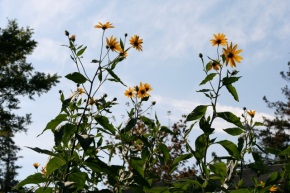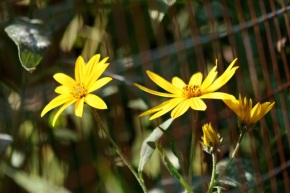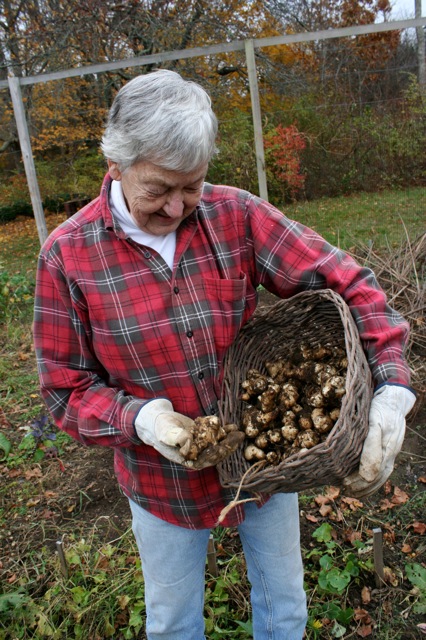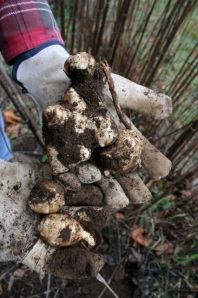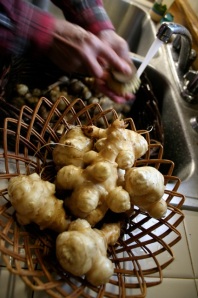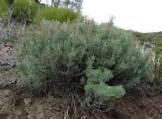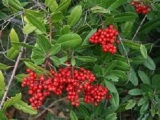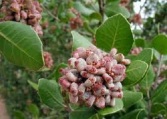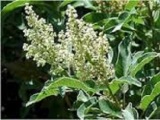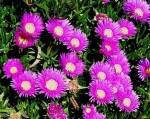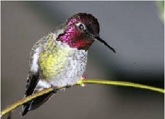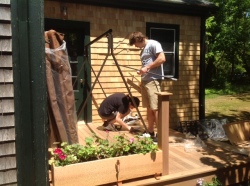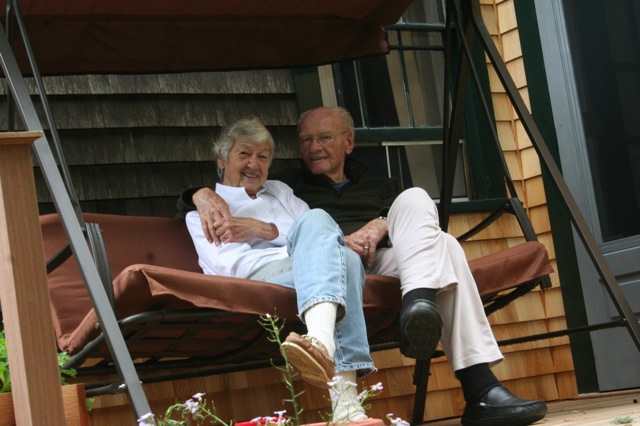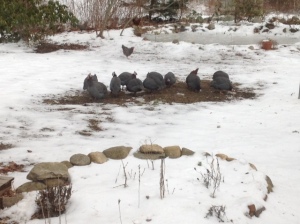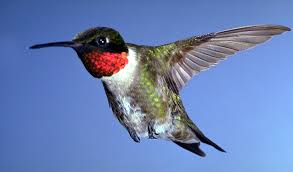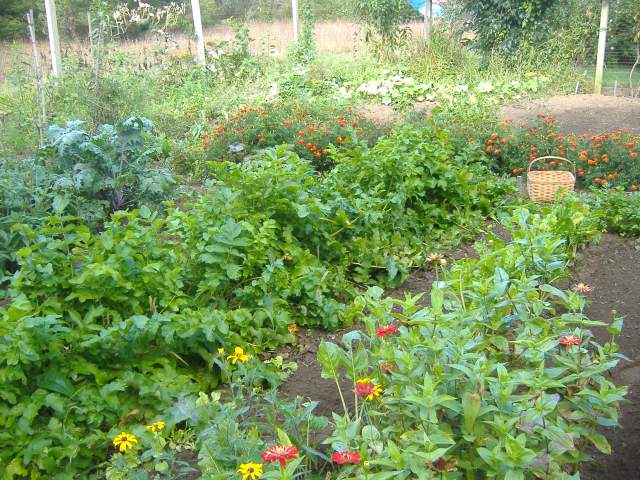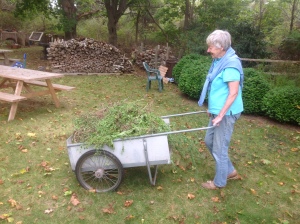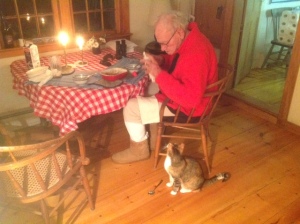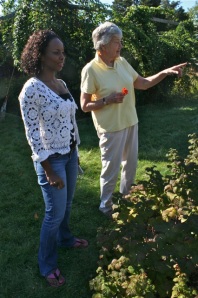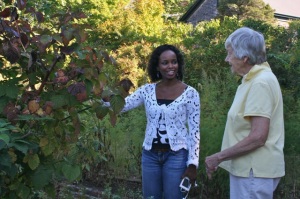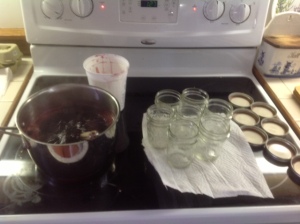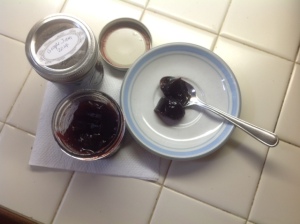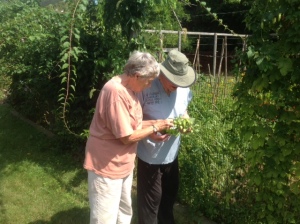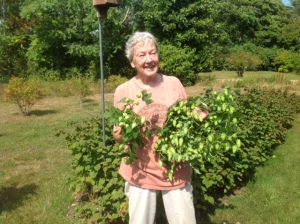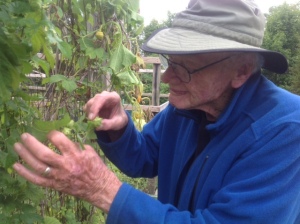Photos by Lynn Christoffers
Despite the warnings that Jerusalem artichokes proliferate alarmingly, several years ago I planted a dozen plants that someone had given me along the back, west facing fence of the vegetable garden.
Jerusalem artichokes have nothing to do with either Jerusalem or artichokes. The plants are a type of sunflower and the knobby roots are what can be eaten. The name apparently morphed out of the Italian word girasole, meaning turning to the sun, and artichoke from its taste, which is vaguely like artichokes.
Sure enough, that first year they grew tall, healthy stalks topped with small, bright sunflowers that I cut for floral arrangements. The plants are native to the Vineyard, and the roots were an important food source for the Wampanoags.
We Vineyarders should be encouraged to grow and eat more Jerusalem artichokes, according to “The Martha’s Vineyard Cookbook” written by Louise Tate King and Jean Stewart Wexler. They’re “a vastly underrated and under consumed vegetable.”
Growing them is easy. In late fall, throughout the winter, and into the following spring, I dug into the general area of the artichoke stalks and in one shovelful would unearth a half dozen of the tubers. They came up clean, pest-free, tawny-skinned, and resembling three-dimensional fat gingerbread men.
It’s no wonder the Wampanoags depended upon them for food. You can eat them raw or cooked. They have a texture like water chestnuts and have a delicate, nutty flavor. Like potatoes, they can be steamed, baked, boiled, or fried. They’re good in stews, soups, and mashed up with another vegetable.
I dug up several bushel baskets of the roots the first year, that from only twelve plants. I read recently that one plant can produce anywhere from 75 to 200 tubers a season, and I believe it.
In some ways, they were ideal plants for the garden. They grew with absolutely no attention. Along the fence, they made a good screen against the drying west wind. They thrived. In fact, after the first year I was pulling them out like weeds.
They’re an excellent food source. About ten percent protein, they have no starch, no oil, and are an ideal food for diabetics, as they are rich in inulin, a substance that diabetics can tolerate better than other sweeteners.
But what can you do with bushels of Jerusalem artichokes?
They don’t store well, hence you don’t often find them in stores, and you really need only a few of the tubers to get you through a week of recipes.
After battling the enthusiastic growth of these native tubers, and tiring of a diet of Jerusalem artichokes in every possible guise, I decided to rid my garden of them. This was a multi-year project. After digging up every Jerusalem artichoke tuber I could find in the fall, the next spring thirty or more of the sprouts greeted me.
The spring before Howie came into my life, I figured I had won the battle of the Jerusalem artichokes. I was sure I had rid the garden of them.
Howie’s and my first spring, I was showing him the garden and the areas where the Jerusalem artichokes had grown.
He was interested. “Why the name, and what were they like?” He was leaning on one of the shovels.
I described them and explained how the Wampanoags depended upon them for food. I told him how I had finally eradicated them, and added, “They’re supposed to be a folk remedy for diabetes.” I laughed. “Actually, they really are known as an ideal food for diabetics.”
Howie was quiet.
“What are you thinking?” I asked, turning to him.
“I’m diabetic,” he answered.
The next day I checked the former Jerusalem artichoke patch again. And the next day and the next. Maybe, just maybe, I had missed one or two of the plants.
I had. The distinctive wide, bright green leaves of a young Jerusalem artichoke plant were sprouting among the young lettuce plants.
Jerusalem artichokes can’t be eradicated.
Now that fall is here, four tall stalks are growing along the fence, which means a multitude of tubers, which means when I dig under them sometime later this week, I’ll probably find enough Jerusalem artichokes to keep us going all winter.
The tubers are well known in Turkey, where my niece, Dionis, lived as a child. She gave me several recipes I’ve tried and will cook for Howie.
CREAMY SUNCHOKE SOUP
A native American vegetable, the sunchoke (also known as Jerusalem artichoke) is the tuber of a pretty yellow sunflower. The tuber itself is knobby and homely, but it has a lovely, mild flavor and a fantastic crisp texture when eaten raw. It also cooks very nicely — baked, boiled and mashed, or sauteed. In this soup, the sunchokes are cooked until they are very soft, them pureed. Texture is critical here, so make sure you get the soup really smooth. (A good blender will do this better than a food processor.)
1-1/2 pounds sunchokes
1 tablespoon butter or vegetable oil
2 cups minced onion
1 teaspoon salt (possibly more, to taste)
4 cups water
1 teaspoon sugar or honey
2 cups buttermilk
1/2 teaspoon white pepper (or to taste)
Mild paprika for the top
Peel the sunchokes, or just scrub them well with a stiff brush, and chop them coarsely.
Melt the butter or heat the oil in a soup pot or Dutch oven. Add the onion and salt, and stir well. Cover and cook for about 10 minutes over medium-low heat, stirring a few times. You want the onion to get very soft, but not brown.
Stir in the sunchokes, cover again, and cook for 5 minutes.
Add the water and sugar or honey and bring to a boil. Turn the heat way down, cover, and simmer for 20 to 30 minutes, or until the sunchokes are tender enough to be pierced easily with a fork. Sunchokes tend to cook unevenly, so test more than one to make sure they are all very soft.
Puree bit by bit in a blender, adding the buttermilk in batches as you go. Return to a clean pot, add white pepper to taste, and adjust the salt, if necessary.
Heat very gently (don’t boil), and serve hot, topped with a few croutons, if desired, and a dusting of mild paprika to give it a finished look.
Yield: About 6 servings
Preparation time: A little over an hour (15 minutes of work)
This soup will keep for several days if stored in an airtight container in the refrigerator.
from “Vegetable Heaven”
Mollie Katzen
JERUSALEM ARTICHOKE SALAD
This is very like a potato salad, but with a more interesting taste and not quite so mealy. It is served chilled and makes a fine summer supper dish.
1 pound Jerusalem artichokes
whites of 2 hard-cooked eggs
1 large red bell pepper
1 large dill pickle
green olives
pickled pearl onions
1 crisp stalk celery
2/3 cup fresh green peas, steamed quickly
salt and pepper
Steam the artichokes 10 to 15 minutes, peel, and then chop them along with the egg whites, the bell pepper, the pickle, olives, and onions (to your taste — I use about a dozen each of olives and onions), and the celery. Mix all the ingredients (don’t forget the peas!), and season with salt and pepper. Set it aside to chill while you make this sauce:
OLD-FASHIONED MAYONNAISE SAUCE
yolks of 2 hard-cooked eggs
1 Tbs. lemon juice
1 Tbs. safflower oil
1/4 cup mayonnaise
1/4 cup sour cream
1 tsp. Dijon mustard
salt and pepper
Mash the egg yolks, alternately add the lemon juice and the oil — a few drops at a time — creaming until smooth. Now add the mayonnaise, sour cream, and mustard; mix well, add salt and pepper to taste. Pour this sauce over the salad and toss it up until it is well mixed, being careful not to mash the softer ingredients of the salad. Chill well.
Serves 6
from: “The Vegetarian Epicure”
Anna Thomas
ZEYTINYAGLI YERELMASI
Jerusalem Artichokes Cooked in Olive Oil
serves 4-6
Jerusalem artichoke is a root vegetable that looks similar to ginger-root although the flavor is very different — nutty and a bit like artichoke. It has beige to light brownish-red skin and white to beige flesh. This winter dish is from the western part of Turkey.
1-1/2 pounds Jerusalem artichoke
2 lemons cut in half
1/4 cup virgin olive oil
1 small Spanish onion, finely diced (1/2 cup)
1 carrot, sliced
1/4 cup long-grain rice
2 teaspoons sugar
1 tablespoons lemon juice
3 tablespoons coarsely chopped fresh dill
Salt
Chopped parsley
Lemon wedges
Peel the artichokes and cut each on into 2 to 4 pieces depending on their size. Rub the pieces with the cut lemon halves and place them in a bowl of cold water to prevent discoloration.
Heat the oil in a large saucepan over medium heat and cook the onion gently until it’s softened but not brown. Add the sliced carrot and cook for 1 minute. Drain the artichokes and add them to the pan along with the rice, sugar, lemon juice, and dill. Season with salt. Stir the mixture well.
Pour in 2 cups water, cover the pan, and cook gently for about 30 minutes, or until the Jerusalem artichokes are tender. Add a little hot water if the mixture getrs dry before the artichokes finish cooking. Transfer the mixture to a serving plate and let it cool. Serve at room temperature with a garnish of chopped parsley and lemon wedges.
from
Ozcan Ozan
“The Sultan’s Kitchen”
MASHED JERUSALEM ARTICHOKES
serves 6
active time: 35 minutes start to finish: 1 hour
You’re in the mood to cook venison or maybe duck. This is what you make instead of the usual side of mashed potatoes, when you want texture and something to absorb the rich meat juices. Peeling three and a half pounds of Jerusalem artichokes is not fun, but you will be rewarded by their nutty, elusive flavor.
3-1/2 pounds Jerul\salem artichokes, peeled and cut into 1-inch pieces
1 pound boiling potatoes, peeled and cut into 3/4-inch pieces
1 teaspoon salt
3 cups whole milk
3 tablespoons unsalted butter, softened
Freshly ground black pepper
Combine artichokes, potatoes, salt, and milk in a 5-quart pot, add water to cover by 1 inch, and bring to a simmer. Simmer, uncovered, until vegetables are very tender, about 25 minutes.
Drain vegetables in a colander and return to pot. Using a potato masher, mash vegetables with butter and salt and pepper to taste until smooth.
The dish can be made up to 3 days ahead and refrigerated, covered. Bring to room temperature before reheating, covered, over low heat.
from “The Gourmet Cookbook”
Ruth Reichel
SAUTEED JERUSALEM ARTICHOKES WITH SAGE
Also called a sunchoke, the Jerusalem artichokes is not really an artichoke at all — it’s a small lumpy, brown-skinned tuber that resembles gingerroot and grows from a sunflower. The name is not a reference to the city of Jerusalem, but comes from the Italian word for sunflower, girasole. Butter, lemon juice, and sage flavor the vegetable simply and elegantly.
6 servings
3 pounds Jerusalem artichokes, peeled
1/4 cup (1/2 stick) butter
4-1/2 tablespoons chopped fresh sage or 2 teaspoons dried rubbed sage
1 lemon, halved
Steam Jerusalem artichokes until tender, about 20 minutes. Cool slightly. Cut into 1/4-inch-thick slices. (Artichokes can be prepared 4 hours ahead. Cover and refrigerate.)
Melt butter in heavy large skillet over medium-high heat. Add sage and saute 1 minute. Add artichoke slices and saute until heated through, about 5 minutes. Squeeze juice from lemon halves over and toss to coat. Season artichokes to taste with salt and pepper. Transfer to bowl and serve.
from “The Bon Appetit Cookbook”
Barbara Fairchild

